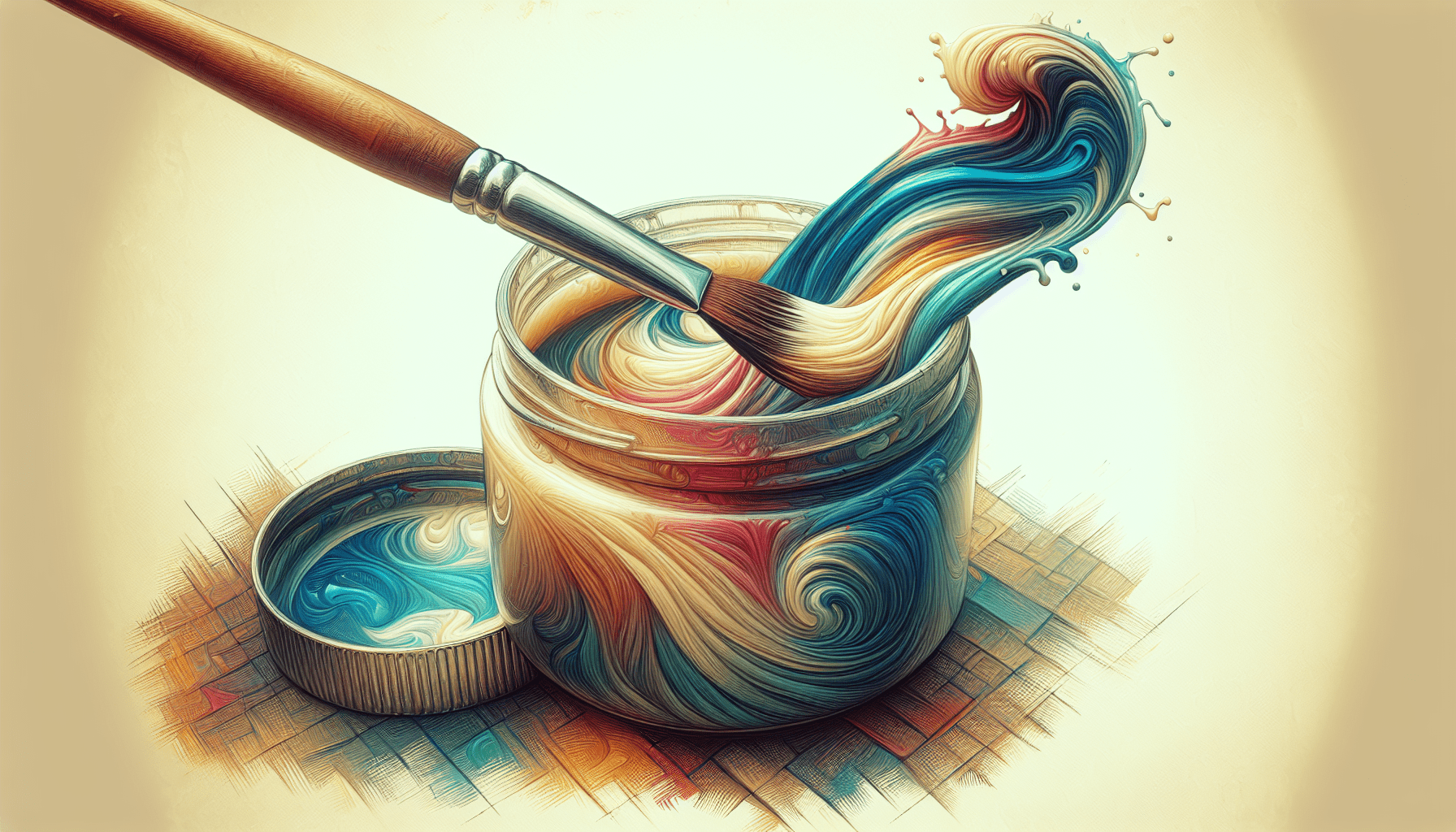When it comes to face painting, it’s essential to prioritize safety and skin health. The question of whether tempera paint can be used as face paint may arise for those seeking an alternative or cost-effective option. However, before applying any type of paint to the sensitive skin on your face, it’s crucial to understand the potential risks and considerations involved. In this article, we will explore the topic of using tempera paint as face paint and provide essential insights to help you make an informed decision for your artistic endeavors.
What is tempera paint?
Definition of tempera paint
Tempera paint is a type of water-based paint that is known for its vibrant colors and versatility. It has a rich history and has been used by artists for centuries due to its quick drying time and opaque finish. Unlike oil or acrylic paints, tempera paint is made using an egg emulsion, which gives it a unique texture and appearance.
Composition of tempera paint
Tempera paint is composed of various pigments, a binding agent (usually egg yolk or egg whites), and a water-based solvent. The pigments give the paint its color, while the binding agent holds the pigments together and helps the paint adhere to a surface. The water-based solvent ensures that the paint has a smooth consistency and can be easily applied.
Types of tempera paint
There are two main types of tempera paint: egg tempera and tempera gouache. Egg tempera is made with egg yolks as the binding agent and is known for its durability and luminosity. It dries quickly and can be layered to create textures and effects. On the other hand, tempera gouache is made with egg whites and has a more opaque finish. It is commonly used for illustration and design work.
Safety concerns when using paint on the face
Potential risks and side effects
Using any type of paint, including tempera paint, on the face can pose potential risks and side effects. These can include skin irritations, allergic reactions, and even more serious health concerns if toxic ingredients are present in the paint. It is essential to be aware of these risks and take appropriate precautions when using paint on the face.
Toxicity of certain paints
Certain paints, particularly those not specifically formulated for use on the face, may contain toxic ingredients such as heavy metals, lead, or solvents. These substances can be harmful or even poisonous when absorbed through the skin or accidentally ingested. It is crucial to avoid using paints with unknown ingredients or those that are labeled as toxic.
Skin irritations and allergies
Paints that are not intended for use on the face can cause skin irritations and allergic reactions in some individuals. The skin on the face is delicate and sensitive, and exposure to certain ingredients in paint can lead to redness, itching, swelling, or even more severe allergic responses. It is essential to be aware of any potential allergies or sensitivities when using paint on the face.

Can tempera paint be used on the face?
Possible dangers of using tempera paint on the face
Using tempera paint on the face can potentially pose several dangers. While tempera paint is generally non-toxic and safe for use on surfaces, it is not specifically formulated for use on the skin. The ingredients in tempera paint may not be suitable for prolonged contact with the delicate facial skin, increasing the risk of irritations or allergic reactions.
Expert recommendations
Experts generally advise against using tempera paint on the face, especially for children or individuals with sensitive skin. It is recommended to opt for paints that are specifically designed for use on the face, as these are formulated with skin-safe ingredients and undergo thorough safety testing. It is essential to prioritize the safety and well-being of the individuals involved, especially when using paint on the face.
Alternatives to tempera paint for face painting
Professional face paints
Professional face paints are specifically formulated for use on the face and are often preferred by artists and performers. These paints are made with high-quality, non-toxic ingredients and undergo extensive safety testing. They come in a wide range of colors and finishes, allowing for greater creativity and versatility in face painting.
Water-based face paints
Water-based face paints are another popular choice for face painting. These paints are easy to apply and remove, making them suitable for various events and occasions. They are usually non-toxic and safe for use on the skin, providing a comfortable and enjoyable face painting experience.
Natural and homemade face paint options
For those who prefer natural or homemade alternatives, there are several options available for face painting. Ingredients such as vegetable-based food coloring, cornstarch, and natural oils can be used to create safe and non-toxic face paints. However, it is essential to research and follow reliable recipes to ensure the safety and effectiveness of these homemade options.

Tips for using tempera paint as face paint
Skin preparation
Before applying any type of paint, including tempera paint, on the face, it is essential to prepare the skin properly. Start by cleansing the face with a gentle cleanser to remove any dirt or oils. Follow this with moisturizer to create a smooth and hydrated base for the paint.
Patch test
Before using tempera paint on the entire face, it is advisable to perform a patch test. Apply a small amount of paint on a small area of skin, such as the inner wrist or behind the ear. Leave it on for 24 hours and observe for any signs of irritation, redness, or allergic reactions. If any adverse reactions occur, it is best to avoid using the paint on the face.
Application techniques
When using tempera paint as face paint, it is important to apply it carefully and evenly. Use clean brushes or sponges to apply the paint, starting with a small amount and building it up as needed. Take care to avoid getting paint in the eyes, nose, or mouth, as these areas are more sensitive.
Removal and cleanup
After enjoying face painting with tempera paint, it is crucial to remove the paint thoroughly and gently. Use a mild cleanser or baby wipes to remove the paint from the face. Avoid scrubbing or rubbing forcefully, as this can irritate the skin. Follow up with a moisturizer to soothe and hydrate the skin after the paint removal.
DIY face paint recipes
Edible face paint recipes
Edible face paint recipes are a great option for children or individuals who may accidentally ingest the paint. Ingredients such as cornstarch, food coloring, and natural sweeteners can be used to create safe and tasty face paints. However, even with edible recipes, it is important to ensure that the ingredients do not cause any adverse reactions or allergies.
Non-toxic face paint recipes
Non-toxic face paint recipes can be made using ingredients commonly found in households. Natural food coloring, cornstarch or flour, and skin-safe oils can be combined to create non-toxic face paints. It is essential to follow reliable recipes and avoid any ingredients that may cause allergic reactions or skin irritations.
Ingredients to avoid in homemade face paint
When making homemade face paints, there are certain ingredients that should be avoided to ensure safety. Some examples include toxic substances like acrylics or oil-based paints, as well as ingredients that may cause allergies or irritations such as nut oils or artificial fragrances. It is crucial to research and carefully select ingredients to avoid any potential harm.
Safety precautions for face painting
Use only non-toxic and hypoallergenic products
Whether using professional face paints, water-based paints, or homemade options, it is vital to ensure that the products used are non-toxic and hypoallergenic. Check the labels and ingredients to ensure that the paints do not contain any harmful substances or potential allergens.
Avoid painting near eyes, nose, and mouth
When applying face paint, it is important to avoid painting near the eyes, nose, and mouth, as these areas are more sensitive and prone to irritation. By focusing on other parts of the face, such as cheeks or forehead, the risk of accidental contact with these sensitive areas is minimized.
Do not share face paint brushes or sponges
To prevent the spread of bacteria or infections, it is crucial not to share face paint brushes or sponges. Each individual should have their own set of clean brushes or sponges to minimize the risk of cross-contamination. Regularly clean and disinfect the brushes and sponges after each use.
Remove face paint promptly
After the face painting is completed, it is important to remove the paint promptly. Leaving the paint on for an extended period can increase the risk of skin irritations or clogged pores. Use a gentle cleanser or baby wipes to remove the paint, followed by moisturizer to soothe the skin.
Benefits of using professional face paints
Higher quality and safety standards
Professional face paints are manufactured to meet higher quality and safety standards. They undergo strict testing to ensure that they are safe for use on the face and do not contain any harmful substances. Choosing professional face paints provides peace of mind and reduces the risk of adverse reactions.
Wide range of colors and finishes
Professional face paints offer a wide range of colors and finishes, allowing for more creativity and versatility in face painting. From vibrant primary colors to shimmering metallics, professional face paints provide endless possibilities for creating intricate designs and stunning effects.
Longevity and durability on the skin
Professional face paints are designed to be long-lasting and durable on the skin. They have excellent coverage and can withstand movements, perspiration, and mild rubbing without smudging or fading. This ensures that the face paint remains vibrant and intact throughout the duration of the event or performance.
Cleaning and storing face paints
Proper cleaning techniques
To maintain the quality and longevity of face paints, it is important to clean them properly after each use. Use mild soap or specialized face paint cleansers to remove any residue or buildup from the paints. Clean brushes and sponges thoroughly to prevent the transfer of colors and ensure proper hygiene.
Storage recommendations
Proper storage of face paints is essential to prevent drying out or contamination. Keep the paints in a cool and dry place, away from direct sunlight or excessive heat. Ensure that the containers are tightly sealed to prevent evaporation and maintain the consistency of the paints.
Expiration dates
Face paints, especially professional ones, often have expiration dates. It is important to check the expiration dates and dispose of any paints that have expired. Expired paints may lose their effectiveness, become prone to bacterial growth, or cause unexpected reactions on the skin.
Conclusion
Final thoughts on using tempera paint as face paint
While tempera paint may be a common household item and suitable for various art projects, it is not recommended for use as face paint. The ingredients in tempera paint may not be skin-safe or suitable for prolonged contact with the delicate facial skin. To ensure the safety and well-being of individuals, it is best to use paints specifically formulated for use on the face.
Importance of prioritizing safety
When it comes to face painting, safety should always be a top priority. Whether using professional face paints, water-based paints, or homemade options, it is crucial to choose non-toxic and hypoallergenic products. Following proper skin preparation, application techniques, and cleaning and storage practices ensures a safe and enjoyable face painting experience for everyone involved.



